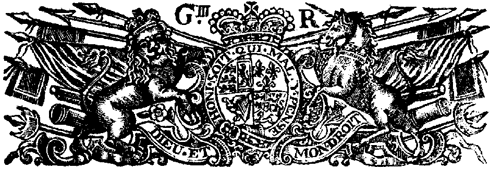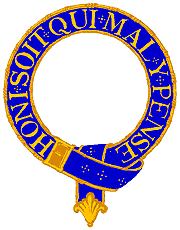

The First Foot Guards
We are a Revolutionary War
reenactment group based in Boston MA,
accurately portraying the royal household regiment that is now known as
The Grenadier Guards
Honi soit qui mal y pense!
This is the motto that you are carrying on the brass plate (we hope it's not bronze) on your cartridge box. So how come a British unit displays a French motto?

Well, it all goes back to heraldry and chivalry…
Heraldry is the study of coats of arms and badges, chivalry is a knightly code of conduct.
Both studies take us back to the origin of the Most Noble Order of the Garter which was founded in 1348 by King Edward III as a noble fraternity consisting of the King, the Prince of Wales (or heir-apparent to the throne) and 24 Knights Companion. It is to this day the highest of the English orders, with a membership of under 30 people.
King Edward was the last of the Plantagenet kings, and had a penchant for ceremonial, and for fighting the Scots and the French. He set up a round table at Windsor, in emulation of that established by King Arthur, and created the Order of the Garter.
The reasons why the badge of the Order is a garter, and the significance of the motto are lost in antiquity. There are several romantic stories referring to a lady at court who dropped her garter (usually attributed to the Countess of Salisbury, future mother of King Richard II). The King is said to have picked up the garter, chivalrously exclaiming "Shame be to him who thinks evil of it." …or "Honi soit qui mal y pense".
The contemporary historian Froissart writes about the foundation of the Order, but does not mention any romantic tale associated with it. (Froissart's Chronicles, by the way, are good reading!)
The story of the Countess is certainly chivalric and romantic, but may be nothing more than medieval urban legend. CW Scott-Giles, a noted heraldic writer, states that the legend seems to have originated in France, possibly to bring scorn to the new Order. Certainly Edward at this time was assiduously pursuing his claim to the throne of France. He even had his royal coat of arms changed to reassert this claim! The blue and gold colors of the Garter are the French royal colors. Prosaically enough, the motto may also refer to the King's claim to the French throne.
The First Foot Guards were given royal permission to bear the badge of the Garter: a singular honor, since this same garter encircles the coat of arms of the monarch.
As the highest and oldest English Order of Chivalry, the Garter is one of the most important of all such Orders throughout the world. When the Order is conferred upon a person, he becomes a knight, and assumes the right to use the title "Sir" before his name. (Ladies become a "Dame"). The holders of the Order are entitled to add the letters KG (Knight of the Most Noble Order of the Garter) after their surnames or title. Our illustrious commander, The Lord Middleborough, would not be likely to be a member of this exclusive Order. Upon recognition of his martial talents, he would be inducted into the Order of the Bath, as was Admiral Lord Nelson, Lord Bronte. The initials KB would be duly added to Lord Middleborough's style.
The patron saint of the Order is St George (patron saint of soldiers and also of England) and the home of the Order is St George's Chapel, Windsor. Every knight is required to display a banner of his arms in the Chapel, together with a helmet and crest, coat of arms, sword and an enamelled stallplate above and on his pew in the choir. If you're ever at Windsor Castle, you should make a point of seeing this bold and colorful display of heraldry. This achievement is taken down on the knight's death (and the insignia are returned to the Sovereign), but the stallplates remain as a memorial and these now constitute one of the finest collections of heraldry in the world. Every St. George's Day (April 23rd of course!) the Monarch and Knights walk in triumphal procession at Windsor Castle to St. George's Chapel, preceded by Her Majesty's heralds.
The insignia of the Order have developed over the centuries: starting with a garter and badge depicting St George and the Dragon. A collar was added in the sixteenth century, and the star and broad riband in the seventeenth century. Although the collar may not be decorated with precious stones, the other insignia can be decorated according to taste. George IV (formerly the Prince Regent under George III) was well-known for his vanity, and had 55 different Garter badges of varying styles. King Charles I was proud to wear his insignia at his execution in 1649.
A fine cloak and hat complete the insignia. Hats are very much like our battalion hatt-capps, but with white feathers (and made from more costly stuff!)
The garter within a star is the badge that you're likely to see on innumerable pub signs in England. There are many "Star and Garter" hostelries!
But why French on the motto? Old heraldic mottoes generally use Latin or Old French (Modern ones are increasingly in English. Scots 'slogans' are in Gaelic.) Basically, Latin or French were the available choice then. If Edward III wanted to 'needle' the French about his territorial claims, the natural choice for the motto would then be French… and shame be to him who thought evil of his claim!
If you're ever in Merry England and you find yourself in the Star and Garter, then raise a toast to King Edward III. Honi soit qui mal y pense!
Guardsman Graeme Marsden